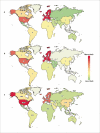A pragmatic view on pragmatic trials
- PMID: 21842619
- PMCID: PMC3181997
- DOI: 10.31887/DCNS.2011.13.2/npatsopoulos
A pragmatic view on pragmatic trials
Abstract
Clinical trials have been the main tool used by the health sciences community to test and evaluate interventions, Trials can fall into two broad categories: pragmatic and explanatory. Pragmatic trials are designed to evaluate the effectiveness of interventions in real-life routine practice conditions, whereas explanatory trials aim to test whether an intervention works under optimal situations. Pragmatic trials produce results that can be generalized and applied in routine practice settings. Since most results from exploratory trials fail to be broadly generalizable, the "pragmatic design" has gained momentum. This review describes the concept of pragmatism, and explains in particular that there is a continuum between pragmatic and explanatory trials, rather than a dichotomy. Special focus is put on the limitations of the pragmatic trials, while recognizing the importance for and impact of this design on medical practice.
Los ensayos clínicos han sido la principal herramienta empleada por la comunidad de las ciencias de la salud para probar y evaluar las intervenciones. Los ensayos se pueden clasificar en dos grandes categorías: pragmáticos y explicatívos. Los ensayos pragmáticos están diseñados para evaluar la eficacia de las intervenciones en situaciones de la práctica rutinaria en la vida real, mientras que los ensayos explicativos tienen como objetivo probar si una intervención funciona en situaciones óptimas. Los ensayos pragmáticos generan resultados que pueden ser generalizables y aplicables en ambientes de la práctica habitual. Dado que la mayor parte de los resultados de los ensayos explicativos han dejado de ser amplíamente generalizables, el “diseño pragmático” ha cobrado fuerza. Esta revisión describe el concepto de pragmatismo y explica, en particular, que más que una dicotomía hay un continuo entre los ensayos pragmáticos y los explicatívos. Se pone especíal atención a las limitaciones de los ensayos pragmáticos, a la vez que se reconoce la importancia y el impacto de este diseño en la práctica médica.
Les études cliniques ont été le principal outil utilisé dans la communauté scientifique médicale pour tester et évaluer les traitements. Les études se répartissent en deux grandes catégories: les études pragmatiques et les études explicatives. Les études pragmatiques sont conçues pour évaluer l'efficacité des traitements dans des conditions de pratique quotidienne de la vie réelle, alors que les études explicatives ont pour but de tester un traitement en conditions optimales. Les études pragmatiques fournissent des résultats qui peuvent être généralisés et appliqués en pratique quotidienne, ce qui n'est pas le cas pour la plupart des études explicatives, et le «schéma pragmatique» a donc le vent en poupe. Cet article décrit le concept de pragmatisme et explique en particulier qu'il existe un continuum entre les études pragmatiques et explicatives, plutôt qu'une dichotomie, il est porté un regard particulier sur les limites des études pragmatiques, tout en reconnaissant leur importance et leur impact sur la pratique médicale.
Figures



References
-
- Grimes DA., Schulz KF. Bias and causal associations in observational research. Lancet. 2002;359:248–252. - PubMed
-
- Zwarenstein M., Oxman A. Why are so few randomized trials useful, and what can we do about it? J Clin Epidemiol. 2006;59:1125–1126. - PubMed
-
- Weiss NS., Koepsell TD., Psaty BM. Generalizabilityof the results of randomized trials. Arch Intern Med. 2008;168:133–135. - PubMed
-
- Schwartz D., Lellouch J. Explanatory and pragmatic attitudes in therapeutical trials. J Chronic Dis. 1967;20:637–648. - PubMed
Publication types
MeSH terms
LinkOut - more resources
Full Text Sources
Medical
